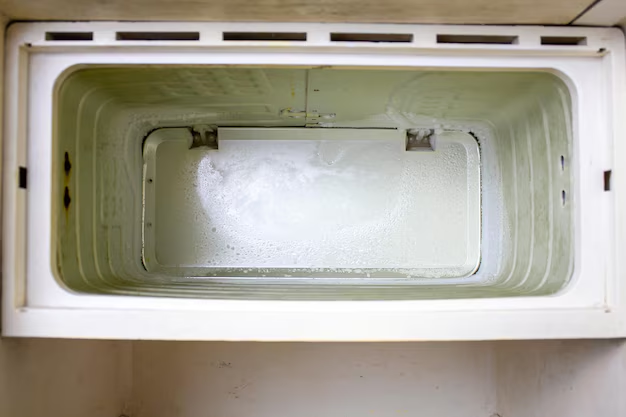Banishing Refrigerator Mold: A Complete Guide to Keep Your Fridge Fresh
Picture opening your refrigerator for a midnight snack, only to be greeted by an unpleasant sight: mold. This scenario is not uncommon, as refrigerators, if not properly maintained, can become mold hotspots. But fear not—getting rid of mold and preventing its return is completely doable. Let's explore how to tackle this issue effectively.
Understanding Mold in Your Fridge
What Is Mold?
Mold is a type of fungus that can appear in various colors, such as black, white, green, or even pink. It thrives in damp, dark environments, feeding on organic material, which makes your refrigerator a potential haven if conditions are right.
Why Does Mold Grow in Refrigerators?
Refrigerators are meant to preserve food by keeping it cool and dry, but various factors can create a conducive environment for mold growth:
- Humidity: High moisture levels can promote mold, especially if there’s a leak or if produce emits excess water.
- Lack of Cleaning: Residual food particles or spills left unattended provide a food source for mold.
- Improper Food Storage: Uncovered or spoiled foods release mold spores.
- Temperature Fluctuations: If the fridge isn't consistently cold, it can increase humidity and encourage mold.
How to Get Rid of Mold in Your Refrigerator
Gather the Necessary Supplies
Before starting, here’s a checklist of what you’ll need:
- Gloves and mask to protect yourself from spores.
- White vinegar or baking soda: Natural mold killers free from harsh chemicals.
- Warm water and dish soap: Basic cleaning staples.
- Scrub brush or sponge: For scrubbing surfaces.
- Microfiber cloths or paper towels: To wipe down cleaned areas.
- Trash bags: For disposing of spoiled food and used towels.
Step-by-Step Mold Removal
Turn Off the Refrigerator
- Safety First: Unplugging the fridge prevents electric shocks and doesn’t overwork the appliance while cleaning.
Remove All Items
- Sort Through: Discard moldy or expired items, as they may reintroduce spores once the fridge is clean.
Disassemble Shelves and Drawers
- Ease of Cleaning: Removing these allows you to thoroughly clean all surfaces. If they’re removable, wash them separately in the sink with dish soap and warm water.
Prepare Cleaning Solution
- Natural Cleaners: Mix equal parts warm water and white vinegar, or use a tablespoon of baking soda in a quart of water.
Scrub All Surfaces
- Thorough Cleaning: Use your brush or sponge soaked in the solution to scrub down every surface, including door seals and crevices.
Rinse and Dry
- Prevent Residue: Wipe the surfaces with a cloth dampened in clean water and dry with a microfiber cloth.
Sanitize Using Vinegar Spray
- Extra Step: Even after cleaning, mist surfaces with white vinegar and leave it to air-dry—its acidity deters future mold growth.
Proper Waste Disposal
Dispose of all used cleaning supplies, like paper towels, in a tightly sealed bag to avoid spreading spores elsewhere in your home.
Preventing Future Mold Growth
Consistent Cleaning Routine
- Weekly Check: Regularly inspect for spills or expired products.
- Monthly Deep Clean: Empty the refrigerator and clean all surfaces.
Effective Organization
- Use of Containers: Store foods in airtight containers to minimize moisture and cross-contamination.
- Clear Labels: Clearly label foods with dates to keep track of freshness.
Temperature and Moisture Control
- Set the Right Temperature: Keep your fridge at or below 40°F (4°C).
- Humidity Boxes: Use absorbers if humidity is an issue.
Additional Tips for Mold-Free Living
Use Natural Deodorizers
- Baking Soda Boxes: Place an open box in the fridge to absorb smells and dampness.
- Activated Charcoal: Known for odor and moisture absorption, it can be a good alternative.
Regular Maintenance Checks
- Inspect Seals: Ensure door seals aren't cracked, as they can let warm air in.
- Check for Leaks: Prevent water accumulation by examining drain pan and lines.
Food Storage Best Practices
- Avoid Overstuffing: Allows for better air circulation, reducing mold chances.
- FIFO Method (First In, First Out): Use older products before new ones to ensure nothing is forgotten and spoiled.
Quick Reference: Mold Management Cheat Sheet
Here are the top points to keep your refrigerator mold-free:
- 🧽 Regular Cleaning: Once a month, deep clean your fridge.
- ⚡ Use Natural Mold Deterrents: Spritz vinegar for ongoing protection.
- 📦 Store Smart: Use airtight containers to reduce moisture and contamination.
- 🌡️ Maintain Temperature: Ensure fridge is consistently at 40°F (4°C) or below.
- 🗓️ Check Food Dates: Practice FIFO for fresh storage.
- 🔍 Monitor and Replace: Swap out baking soda every few months.
By following these steps, expert recommendations, and understanding the science behind mold growth, you'll keep your refrigerator clean and your food safe. A regular cleaning routine and good food storage habits are key to preventing mold, ensuring that you can enjoy your well-stocked fridge without worry. So, tackle that mold, embrace your clean fridge, and enjoy the freshness in every meal!
